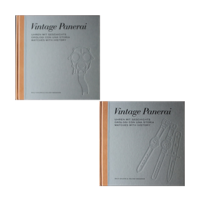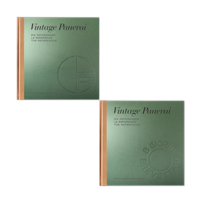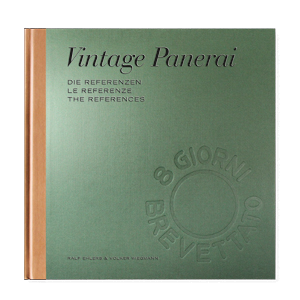Taking a close look at a Ref. 3646 / Type C… “Red Radiomir”
by Volker on Jul.23, 2014, under Allgemein
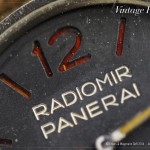 Spot on “Red Radiomir”! Only a few watches have been aged in the way that the black color of the dial faded to grey and the luminous “Radiomir” of the four numbers 3, 6, 9 and 12, as well as the eight 5-minutes-markers turned into a deep and intensive red color. More info on this amazing 3646 / Type C watch has been published earlier and back in 2010.
Spot on “Red Radiomir”! Only a few watches have been aged in the way that the black color of the dial faded to grey and the luminous “Radiomir” of the four numbers 3, 6, 9 and 12, as well as the eight 5-minutes-markers turned into a deep and intensive red color. More info on this amazing 3646 / Type C watch has been published earlier and back in 2010.
A similar watch with dark red aged “Radiomir Panerai” dial is featured in our book “History1” in chapter I.
The story behind “History2”
by Volker on Jul.21, 2014, under Allgemein
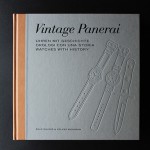 Our first book, published in 2007 and entitled “Watches with History” opened with the words “In this book we would like to give the reader an overview of historic Panerai watches and their documented history.” 2013, six years passed since then, during which we have embarked on many interesting trips into the past while researching this subject. In 2012 we were able to take an even deeper and more comprehensive look at the wearers and the uses of these watches in the book “History1”. In the book “History2” we once again take our readers on a journey through time with five more stories; five exciting and moving fates of courageous men, for whom their Panerai watch was not an item of jewellery, but rather an important piece of equipment. At the end of each chapter we document the current condition of the watch in question, its special features and technical details with a current extract from our database, which we have set up and which we are expanding constantly.
Our first book, published in 2007 and entitled “Watches with History” opened with the words “In this book we would like to give the reader an overview of historic Panerai watches and their documented history.” 2013, six years passed since then, during which we have embarked on many interesting trips into the past while researching this subject. In 2012 we were able to take an even deeper and more comprehensive look at the wearers and the uses of these watches in the book “History1”. In the book “History2” we once again take our readers on a journey through time with five more stories; five exciting and moving fates of courageous men, for whom their Panerai watch was not an item of jewellery, but rather an important piece of equipment. At the end of each chapter we document the current condition of the watch in question, its special features and technical details with a current extract from our database, which we have set up and which we are expanding constantly.
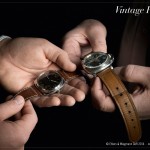 While many of the questions today about historic Panerai watches and their wearers are often the same, the traces we have followed on our research trails and the answers we have found could not be more different. The starting point of our journeys of discovery is always a Panerai watch that still exists today. Every story that we have brought to light has taken us to our destination by very different paths. These stories, which have in the most literal sense “resurfaced”, provide the reader with answers to the questions: Who used the watch? Where and under what conditions did the training of the special marine units take place? When and to what purpose were the missions carried out? And further: How and by which means were the combat swimmer missions conducted? How do the veterans now assess their deployments at that time? We have pursued these questions and, thanks to the help of some of the surviving veterans of the Second World War, their descendents, and through the analysis of previously unknown documents such as personal notes, interviews conducted with the veterans or documents from enemy archives and their espionage departments, we managed to compile very impressive and authentic chapters.
While many of the questions today about historic Panerai watches and their wearers are often the same, the traces we have followed on our research trails and the answers we have found could not be more different. The starting point of our journeys of discovery is always a Panerai watch that still exists today. Every story that we have brought to light has taken us to our destination by very different paths. These stories, which have in the most literal sense “resurfaced”, provide the reader with answers to the questions: Who used the watch? Where and under what conditions did the training of the special marine units take place? When and to what purpose were the missions carried out? And further: How and by which means were the combat swimmer missions conducted? How do the veterans now assess their deployments at that time? We have pursued these questions and, thanks to the help of some of the surviving veterans of the Second World War, their descendents, and through the analysis of previously unknown documents such as personal notes, interviews conducted with the veterans or documents from enemy archives and their espionage departments, we managed to compile very impressive and authentic chapters.
It was and remains very important to us to endow the veterans with a “voice” in this book, to tell their true story. This book does not represent a political statement about the period of the Second World War – rather, we have tried document the historically provable facts about the circumstances and events of that time. This book outlines the personal experiences of the combat swimmers and describes in the smallest detail their fate, which has, during conversations or in written correspondence, evoked at times painful memories and great emotions after many decades. Without their inspiration and great support, this book would never have been possible in such comprehensive form. For this we wish to express our deep gratitude to “our” veterans.
The four watches presented in this book (Reference 3646) were in action under “real” battle conditions in the Second World War. They accompanied their original owners since combat swimmer training and indeed for many years after the war.
Our book “History2″ is in stock. It can be ordered directly at our bookstore. Enjoy reading!
[Ralf Ehlers & Volker Wiegmann]
Spot on: chaper IV of “History1”
by Volker on Jul.18, 2014, under Allgemein
 CHAPTER IV – “Mario Arillo”
CHAPTER IV – “Mario Arillo”
(165 pages, 106 photos, 7 technical illustrations)
The chapter on Mario Arillo begins with an interview conducted with him in 1989. Numerous as yet unpublished pictures and documents from the family possessions of the famous submarine commander from La Spezia augment the personal descriptions of his missions as a means of transport for Italian Gamma swimmers and the SLC units of the Decima MAS.
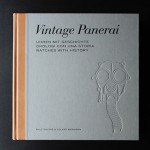 Vintage Panerai “History1”
Vintage Panerai “History1”
26 x 26 cm, 420 pages,
trilingual (= german, italian and english language in one book),
hardback jacket, slipcase.
“History1″ is in stock and can be ordered directly at our bookstore.
Enjoy reading!
[Ralf Ehlers & Volker Wiegmann]
Spot on: chapter III of “History1”
by Volker on Jul.11, 2014, under Allgemein
 CHAPTER III – “Karl-Heinz Kiefer”
CHAPTER III – “Karl-Heinz Kiefer”
(55 pages, 39 photos, 3 technical illustrations)
The story of Karl-Heinz Kiefer, who received fast-track training in the last months of the war, already provided proof in the first edition of this book about period of use of the rare watch-face version of his Panerai watch (Ref. 3646 / Type D with brass dial), which for a long time had been ascribed to an earlier date. Now, his winter training in a toughening-up camp at the Baltic Sea in early 1945 is described in detail.
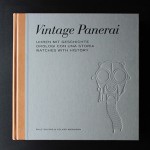 Vintage Panerai “History1”
Vintage Panerai “History1”
26 x 26 cm, 420 pages,
trilingual (= german, italian and english language in one book),
hardback jacket, slipcase.
“History1″ is in stock and can be ordered directly at our bookstore.
Enjoy reading!
[Ralf Ehlers & Volker Wiegmann]
Spot on: chapter II of “History1”
by Volker on Jul.04, 2014, under Allgemein
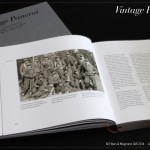 CHAPTER II – “Heinz Pape”
CHAPTER II – “Heinz Pape”
(91 pages, 44 photos, 3 technical illustrations)
For the most part the chapter about Heinz Pape is taken from his surviving diary and presented as a first-person narrative, with comprehensive supplementation. Thanks to extremely rare aerial photographs of the assignment targets described by him and the examination of maps it was possible to analyse his diary entries from WW2 precisely and thus present them to the reader in such an impressive manner – an unique story of a “Kampfschwimmer” unit and his Panerai watch, a Ref. 3646 / Type D with its well known and typical anonymous dial…
 Vintage Panerai “History1”
Vintage Panerai “History1”
26 x 26 cm, 420 pages,
trilingual (= german, italian and english language in one book),
hardback jacket, slipcase.
“History1″ is in stock and can be ordered directly at our bookstore.
Enjoy reading!
[Ralf Ehlers & Volker Wiegmann]
The Kaufhold Radiomir featured at watchtime.net
by Volker on Jun.30, 2014, under Allgemein
The german watch portal www.watchtime.net featured the Vintage Panerai Ref. 3646 / Type D – “The Kaufhold Radiomir” – with an overview about the details of the watch and the history behind its first owner, german frogmen Hanns-Martin Kaufhold.
“The Kaufhold Radiomir” is fully described in our book “History2″ in Chapter VII on 70 pages with 58 photos and 6 technical illustrations. Thanks to www.watchtime.net for putting a spotlight onto Panerai’s DNA. [Ralf Ehlers & Volker Wiegmann]
Spot on: chapter I of “History1”
by Volker on Jun.27, 2014, under Allgemein
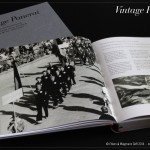 CHAPTER I – “Heinz Günter Lehmann”
CHAPTER I – “Heinz Günter Lehmann”
(75 pages, 38 photos, 4 technical illustrations)
The story of the German elite swimmer Heinz Günter Lehmann and his “Radiomir Panerai” watch (Ref. 3646 / Type C) is told with numerous photos, covering the period from his training in the lagoon of Venice in the summer of 1944 to his countless sporting successes on the international stage after the Second World War. Rare photos and documents, from national and international archives, allied intelligence documents as well as photos provided by his family were added together, followed by the technical details of his watch in chapter I.I with a current excerpt from our historical Panerai database.
 Vintage Panerai “History1”
Vintage Panerai “History1”
26 x 26 cm, 420 pages,
trilingual (= german, italian and english language in one book),
hardback jacket, slipcase.
“History1″ is in stock and can be ordered directly at our bookstore.
Enjoy reading!
[Ralf Ehlers & Volker Wiegmann]
[Ralf Ehlers & Volker Wiegmann]
The Rolex Cal. 618 movement – engine of the 3646
by Volker on Jun.24, 2014, under Allgemein
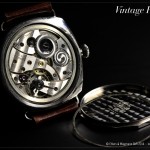 Used in Ref. 3646 watches from Type A to Type G, the Rolex Cal. 618 / Type 1 movement comes without Incabloc shock protection.
Used in Ref. 3646 watches from Type A to Type G, the Rolex Cal. 618 / Type 1 movement comes without Incabloc shock protection.
Typical for this non-incabloc version is the serif font for the letters A-R (french) and F-S (english) engraved on the regulation device. The screwed off caseback next to the case shows the decorations on the inner caseback (completely decorated). More Information about the different finishings on inner casebacks of 3646 watches can befound in our book “History1″ (page 166-167) and in our book “History2″ (page 546-547).
See also a comparing between the Rolex Cal. 618 / Type 1 and the Rolex Cal. 618 / Type 4 movement).
The story behind “History1”
by Volker on Jun.23, 2014, under Allgemein
 For years, the uncompromised functionality, the mechanical precision and an incomparable design have fascinated collectors of the early Panerai diving watches, which were important instruments for their users during their deployments. Exact timekeeping, perfect legibility in the dark and faultless functioning under water were the characteristics that were demanded by the Navy, which the watches from Florence fulfilled reliably.
For years, the uncompromised functionality, the mechanical precision and an incomparable design have fascinated collectors of the early Panerai diving watches, which were important instruments for their users during their deployments. Exact timekeeping, perfect legibility in the dark and faultless functioning under water were the characteristics that were demanded by the Navy, which the watches from Florence fulfilled reliably.
The four stories in our book “History1” take the reader back to the time of the Second World War. With the second, expanded edition of the sold out book “Vintage Panerai – Watches with History” (published 2007) we give collectors of historical Panerai watches a deeper and more comprehensive insight into the wearers and the purpose of these watches. Today, subsequent generations can hardly imagine the conditions under which people lived and carried out their dangerous missions back then. Pictures from the period bear silent and impressive witness to the conditions and living circumstances, which we have also been able to supplement with rare map and image materials from various national and international archives.
For anyone who has collected these watches for some time, a number of questions arise automatically, answers to which cannot be found in any history book or company chronicle. It is simply not enough to know that the watches derive from a certain time and have the characteristics for which they are now famous. Instead, the collector with an interest in history wants to know who once owned the watch, and often tries to find out a name or some other information about the origin of the watch by examining the rarely-found engravings on the case. Happy are those who receive this information directly from the previous owner. But today – after 70 years – this is only seldom possible.
Our database of today existing Panerai watches, which we have built up and which continues to expand, forms the basis for dating and categorising these timepieces. It provides us with precise expertise, in especially rare cases also with information about the first owner of the watch. The findings from this database, together with the information known today about the original owners of the watches, give an insight into the time of their manufacture and use. In the confusion of the Second World War the watches often ended up in the hands of the Allies upon the imprisonment of their owners, the Italian and German combat swimmers, and some of them – to the great joy of many collectors – still re-emerge in this day and age.
Lost forever during their owner’s deployment, destroyed immediately after the assignment to get rid of evidence, exchanged immediately after the war in return for necessary everyday items – in times of bitter desperation such a watch often held no value for its owner and during its final operation changed from being a diving object to a pawning object…
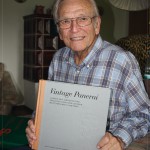 A small number of historic Panerai watches reveal their secrets to the readers of “History1” and answer the ever-recurring question: Who used the watch? When did the operations take place, and to what purpose? And further: where and under what conditions did the comprehensive training of the special maritime unit take place? How and by what means were the deployments of the combat swimmers carried out? What do the veterans think of those missions today? We pursued the answers to these questions and, thanks to the help of some surviving veterans of the Second World War, their descendents, or by means of analysing previously unknown documents such as diaries, interview records or recordings by opposing spies, we managed to compile very impressive and authentic chapters.
A small number of historic Panerai watches reveal their secrets to the readers of “History1” and answer the ever-recurring question: Who used the watch? When did the operations take place, and to what purpose? And further: where and under what conditions did the comprehensive training of the special maritime unit take place? How and by what means were the deployments of the combat swimmers carried out? What do the veterans think of those missions today? We pursued the answers to these questions and, thanks to the help of some surviving veterans of the Second World War, their descendents, or by means of analysing previously unknown documents such as diaries, interview records or recordings by opposing spies, we managed to compile very impressive and authentic chapters.
It was and remains our objective to report factually and comprehensively about the historical Panerai watches and their wearers. “History1” is not a political statement about the time of the Second World War – rather, we have attempted to document the historically proven facts about the circumstances and events of this time, during which the Panerai watches were not items of jewellery for their wearers, but rather an important part of their equipment. It is particularly important to us that this book gives the veterans a “voice” that presents their stories authentically. “History1” describes their very personal experiences and touches on reminiscences, at times in the greatest detail, which in part brought back painful memories and emotions during discussions and in written correspondence with the veterans, even after so many decades. Without their inspiration and great support, this book would not have been possible in this form. For this we would like to express our deepest thanks to “our” veterans.
Our book “History1″ is in stock. It can be ordered directly at our bookstore. Enjoy reading!
[Ralf Ehlers & Volker Wiegmann]
The clean face of a 3646 “Kampfschwimmer”
by Volker on Jun.14, 2014, under Allgemein
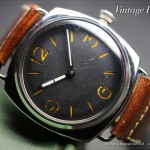 Reduced to the max, simple, clean – the design of the Panerai sandwich dial without the engraved “Radiomir Panerai” as it appears on Panerai watches used by “Kampfschwimmer” units during the 2nd world war.
Reduced to the max, simple, clean – the design of the Panerai sandwich dial without the engraved “Radiomir Panerai” as it appears on Panerai watches used by “Kampfschwimmer” units during the 2nd world war.
The aged numbers and markers of the dial in different colors (from yellow to light orange / amber) are a typical feature of 3646 / Type D watches. The clean face of the dial – just 8 markers, 4 numbers and 2 hands – glowed in the darkness to keep it’s operator “in time”. Waterproof. And of course accurate: functionality can be simple – and something which the users of these watches had to trust in.
This Ref. 3646 / Type D watch is featured in our book “History2″. Read more about the first owners and the missions in which it was used as an important underwater tool in chapter V.



